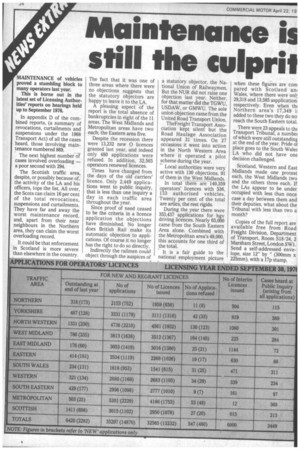Maintenance is still the culprit
Page 26

If you've noticed an error in this article please click here to report it so we can fix it.
MAINTENANCE of vehicles proved a stumbling block to many operators last year.
This is borne out in the latest set of Licensing Authorities' reports on hearings held up to September 1976.
In appendix D of the combined reports, (a summary of revocations, curtailments and suspensions under the 1968 Transport Act) of all the cases heard, those involving maintenance numbered 869.
The next highest number of cases involved overloading — a poor second with 294.
The Scottish traffic area,. despite, or possibly because of, the activity of the LA and his officers, tops the list. All over, the Scots can claim 16 per cent of the total revocations, suspensions. and curtailments. They have far and away the worst maintenance record, and, apart from their near neighbours in the Northern area, they can claim the worst overloading record.
It could be that enforcement in Scotland is more severe than elsewhere in the country. The fact that it was one of three areas where there were no objections suggests that the statutory objectors are happy to leave it to the LA. A pleasing aspect of the report is the total absence of bankruptcies in eight of the 11 areas. The West Midlands and Metropolitan areas have two each; the Eastern area five.
Despite the recession there were 13,232 new 0 licences granted last year, and indeed only 480 applications were refused. In addition, 32,565 operators renewed licences.
Times have changed from the days of the old carriers' licence. Only 2,449 applications went to public inquiry, that is less than one inquiry a day in each traffic area throughout the year.
Since proof of need ceased to be the criteria in a licence application the objections have diminished. No longer does British Rail make its automatic objection to applications. Of course it no longer has the right to do so directly.
Indirectly the railmen could object through the auspices of a statutory objector, the National Union of Railwaymen. But the NUR did not raise one objection last year. Neither, for that matter did the TGWU, USDAW, or GMWU. The sole union objection came from the United Road Transport Union.
TheFreight Transport Association kept silent but the Road Haulage Association appeared 31 times. On 27 occasions it went into action in the North Western Area where it operated a pilot scheme during the year.
– Local authorities were very active with 130 objections, 91 of them in the West Midlands.
In total there are 140,359 operators' licences with 536, 133 authorised vehicles. Twenty per cent of the total are artics, the rest rigids.
During the year there were 353,437 applications for hgv driving licences. Nearly 65,000 came from the South Eastern Area alone. Combined with the Metropolitan area's 49,000, this accounts for one third of the total.
It is a fair guide to the national employment picture when these figures are corn pared with Scotland am Wales, where there were onl] 29,318 and 13,585 aspplicatiorr respectively. Even when tlu Northern area's 17,349 added to these two they do noi reach the South Eastern total.
There were 23 appeals to till Transport Tribunal, a number of which were still outstanding at the end of the year. Pride oi place goes to the South Wales LA who did not have one decision challenged.
Scotland, Western and East Midlands made one protest each, the West Midlands two and the others three each. If the LAs appear to be under occupied with less than once case a day between them and their deputies, what about the Tribunal with less than two a month?
Copies of the full report are available free from Road Freight Division, Department of Transport, Room S18/24, 2 Marsham Street, London SWI. Send a self-addressed envelope, size 12" by " (300mm x 225mm), with a 17p stamp.




















































































